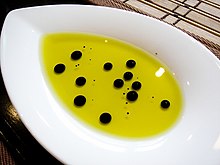Phase separation




Phase separation is the creation of two distinct phases from a single homogeneous mixture.[1] The most common type of phase separation is between two immiscible liquids, such as oil and water. This type of phase separation is known as liquid-liquid equilibrium. Colloids are formed by phase separation, though not all phase separations forms colloids - for example oil and water can form separated layers under gravity rather than remaining as microscopic droplets in suspension.
A common form of spontaneous phase separation is termed spinodal decomposition; it is described by the Cahn–Hilliard equation. Regions of a phase diagram in which phase separation occurs are called miscibility gaps. There are two boundary curves of note: the binodal coexistence curve and the spinodal curve. On one side of the binodal, mixtures are absolutely stable. In between the binodal and the spinodal, mixtures may be metastable: staying mixed (or unmixed) absent some large disturbance. The region beyond the spinodal curve is absolutely unstable, and (if starting from a mixed state) will spontaneously phase-separate.
The upper critical solution temperature (UCST) and the lower critical solution temperature (LCST) are two critical temperatures, above which or below which the components of a mixture are miscible in all proportions. It is rare for systems to have both, but some exist: the nicotine-water system has an LCST of 61 °C, and also a UCST of 210 °C at pressures high enough for liquid water to exist at that temperature. The components are therefore miscible in all proportions below 61 °C and above 210 °C (at high pressure), and partially miscible in the interval from 61 to 210 °C.[2][3]
Physical basis
[edit]Mixing is governed by the Gibbs free energy, with phase separation or mixing occurring for whichever case lowers the Gibbs free energy. The free energy can be decomposed into two parts: , with the enthalpy, the temperature, and the entropy. Thus, the change of the free energy in mixing is the sum of the enthalpy of mixing and the entropy of mixing. The enthalpy of mixing is zero for ideal mixtures, and ideal mixtures are enough to describe many common solutions. Thus, in many cases, mixing (or phase separation) is driven primarily by the entropy of mixing. It is generally the case that the entropy will increase whenever a particle (an atom, a molecule) has a larger space to explore; and thus, the entropy of mixing is generally positive: the components of the mixture can increase their entropy by sharing a larger common volume.
Phase separation is then driven by several distinct processes. In one case, the enthalpy of mixing is positive, and the temperature is low: the increase in entropy is insufficient to lower the free energy. In another, considerably more rare case, the entropy of mixing is "unfavorable", that is to say, it is negative. In this case, even if the change in enthalpy is negative, phase separation will occur unless the temperature is low enough. It is this second case which gives rise to the idea of the lower critical solution temperature.
Phase separation in cold gases
[edit]A mixture of two helium isotopes (helium-3 and helium-4) in a certain range of temperatures and concentrations separates into parts. The initial mix of the two isotopes spontaneously separates into -rich and -rich regions.[4] Phase separation also exists in ultracold gas systems.[5] It has been shown experimentally in a two-component ultracold Fermi gas case.[6][7] The phase separation can compete with other phenomena as vortex lattice formation or an exotic Fulde-Ferrell-Larkin-Ovchinnikov phase.[8]
See also
[edit]References
[edit]- ^ Nic M, Jirat J, Kosata B (1997). "Phase separation". In McNaught AD, Wilkinson A, Jenkins A (eds.). IUPAC Compendium of Chemical Terminology (the "Gold Book") (2nd ed.). Oxford: Blackwell Scientific Publications. doi:10.1351/goldbook.P04534. ISBN 0-9678550-9-8.
- ^ P.W. Atkins and J. de Paula, "Atkins' Physical Chemistry" (8th edn, W.H. Freeman 2006) pp. 186-7
- ^ M. A. White, Properties of Materials (Oxford University Press 1999) p. 175
- ^ Pobell, Frank (2007). Matter and methods at low temperatures (3rd rev. and expanded ed.). Berlin: Springer. ISBN 978-3-540-46356-6. OCLC 122268227.
- ^ Carlson, J.; Reddy, Sanjay (2005-08-02). "Asymmetric Two-Component Fermion Systems in Strong Coupling". Physical Review Letters. 95 (6): 060401. arXiv:cond-mat/0503256. Bibcode:2005PhRvL..95f0401C. doi:10.1103/PhysRevLett.95.060401. PMID 16090928. S2CID 448402.
- ^ Shin, Y.; Zwierlein, M. W.; Schunck, C. H.; Schirotzek, A.; Ketterle, W. (2006-07-18). "Observation of Phase Separation in a Strongly Interacting Imbalanced Fermi Gas". Physical Review Letters. 97 (3): 030401. arXiv:cond-mat/0606432. Bibcode:2006PhRvL..97c0401S. doi:10.1103/PhysRevLett.97.030401. PMID 16907486. S2CID 11323402.
- ^ Zwierlein, Martin W.; Schirotzek, André; Schunck, Christian H.; Ketterle, Wolfgang (2006-01-27). "Fermionic Superfluidity with Imbalanced Spin Populations". Science. 311 (5760): 492–496. arXiv:cond-mat/0511197. Bibcode:2006Sci...311..492Z. doi:10.1126/science.1122318. ISSN 0036-8075. PMID 16373535. S2CID 13801977.
- ^ Kopyciński, Jakub; Pudelko, Wojciech R.; Wlazłowski, Gabriel (2021-11-23). "Vortex lattice in spin-imbalanced unitary Fermi gas". Physical Review A. 104 (5): 053322. arXiv:2109.00427. Bibcode:2021PhRvA.104e3322K. doi:10.1103/PhysRevA.104.053322. S2CID 237372963.
Further reading
[edit]- Khabibullaev PK, Saidov A (April 2013). Phase Separation in Soft Matter Physics: Micellar Solutions, Microemulsions, Critical Phenomena. Berlin Heidelberg: Springer. ISBN 978-3-662-09278-1.






